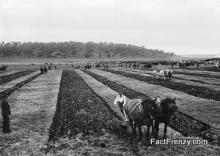History of Demonstration Farming

Although it is sometimes easy to imagine agricultural demonstration activity as simply the promotion of new products and technologies, its history illustrates that demonstration farming is far more than that. In particular, from the industrialisation era onwards, the demonstration of new innovations in agriculture has played a critical role in the development of Western civilisation.
Formal demonstration farming in Europe emerged from the middle of the 1700s from the need to provide sufficient food for a rapidly urbanising population combined with an increased need for food security at a time when there were multiple wars between nation states. At the same time, new trade routes opened up new opportunities and new markets for agricultural produce. However, there was a problem. Many of the farms at the time were managed as subsistence farms producing for themselves and/or for local markets. Consequently, in some regions the (generally privately owned) road system was so bad that moving produce further to the rapidly growing cities was difficult. To improve the roads and infrastructure required investment. For those farmers that wished to progress, demonstration to neighbouring farmers (or tenants) was one way of increasing the wealth of a region and thus enabling the required investments to be made.
To encourage this development “county societies” began to spring up across Europe in the 1700s, such that by the 1770s there were reportedly over 30 such organisations in France alone, several in Switzerland, and others in Leipzig, Württemberg, Hannover, Zurich, Heidelberg, Stockholm, England, and numerous other locations. The primary objective of these societies was to improve the general condition of agriculture of the region through learning and then teaching neighbours by example.
Formal demonstration farms (at that time termed “model” or “pattern” farms) emerged in the last decade of the 18th Century. These were predominantly private farms established by wealthy individuals or organisations (funded by subscription and occasionally with grants of land from the government) with the intent of improving agriculture and the economy within the country. An advertisement for a model farm at Whitfield near Thornbury in the United Kingdom (1842) illustrates how the approach to farm demonstration shows many similarities with today’s. It notes:
“… the farm is open to the visits of any one; every operation performed on it is open to the inspection of all; and reports of its condition, and of the various steps in its progress towards an improved state of cultivation, are to be put forth at intervals.”
A similar pattern farm at Hofwyl in Switzerland (1818) was claimed to be exceptionally effective, i.e.,
“They saw also, in the pattern farm, the most perfect agriculture; and they spread throughout the country a knowledge and a taste for it.”
In America demonstration farming developed in earnest in the beginning of the 1900s with the work of Dr. Seaman Knapp. Knapp initially used the term “demonstration farm” to designate that part of the farm that was being managed according to the instructions of agents working for the Bureau of Plant Industry – with the “demonstration farm” being visited by agents once a month to ensure instructions were followed and provide any additional advice required. It was only at a later point that the term “demonstration farm” was used to refer to farms entirely managed under instruction. The object of a demonstration farm was:
“to place a practical object lesson before the farm masses, illustrating the best and most profitable methods of producing the standard farm crops”
Knapp’s approach to demonstration farms was thus to seed the landscape with farm fields that were being managed under efficient agronomic principles. He notes that demonstration farms had to be managed over an extended period because “the farmer is a natural doubter” and therefore evidence of improved yield may not be initially attributed to improved farming practices. However, by the third year of demonstration neighbours will “have commenced to inquire and follow his example”. Knapp details how this process then leads to change:
“His neighbours ask him how he produced it. He is invited to address public assemblies. He has become a man of note and a leader of the people and cannot return to his old ways. Soon there is a body of such men; a township, a county and finally a state is transformed.”
This is important because it illustrates how early demonstration farms in America were not only centres for education, but also for cultural change – embedding the new improved ways of production within the culture of good farming such that the farmer “cannot return to his old ways”.
Todays demonstration activities perhaps reflect times where commercial objectives and sustainable production have taken over from concerns for food security, cultural change and regional development. Nevertheless, demonstration farming continues to play an important social role. It is PLAIDs ambition to prepare European agriculture for the next hundred years by increasing our understanding of demonstration farming and peer-to-peer learning in and era where climate, communication methods, agricultural technologies, and market and trading systems are rapidly and radically changing.
Author: Rob Burton, Centre for Rural Research, Trondheim, Norway



